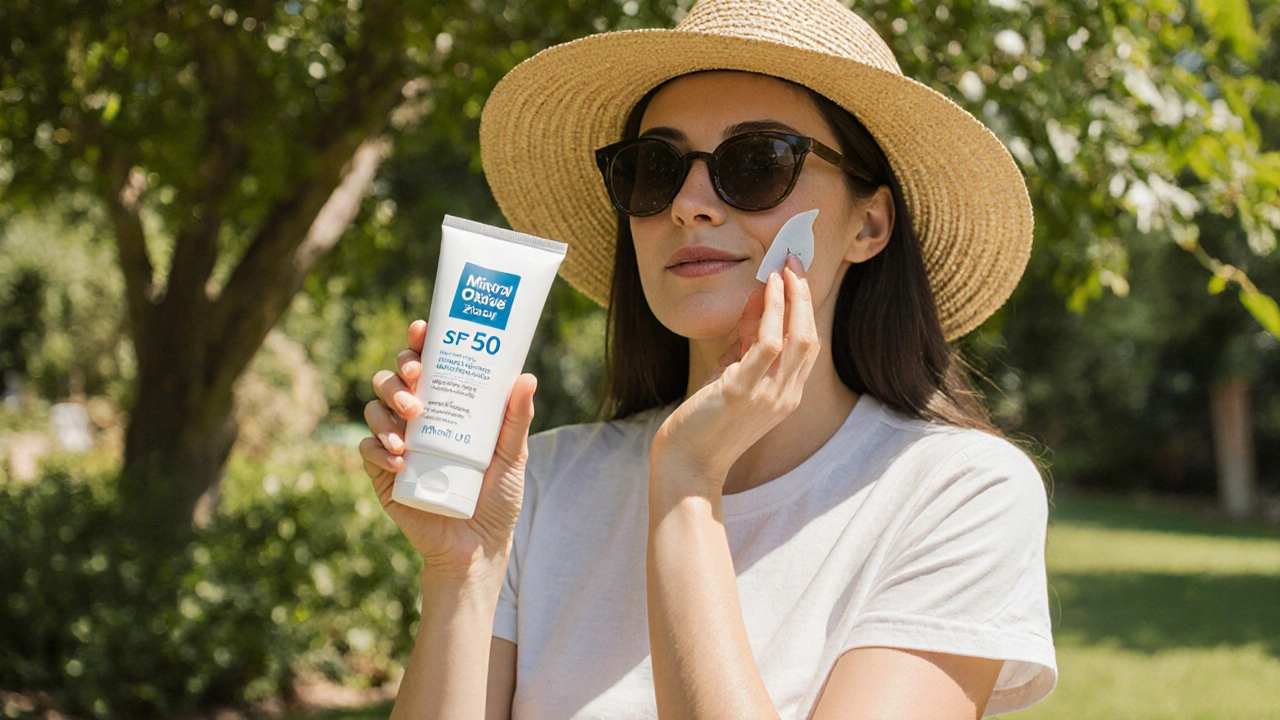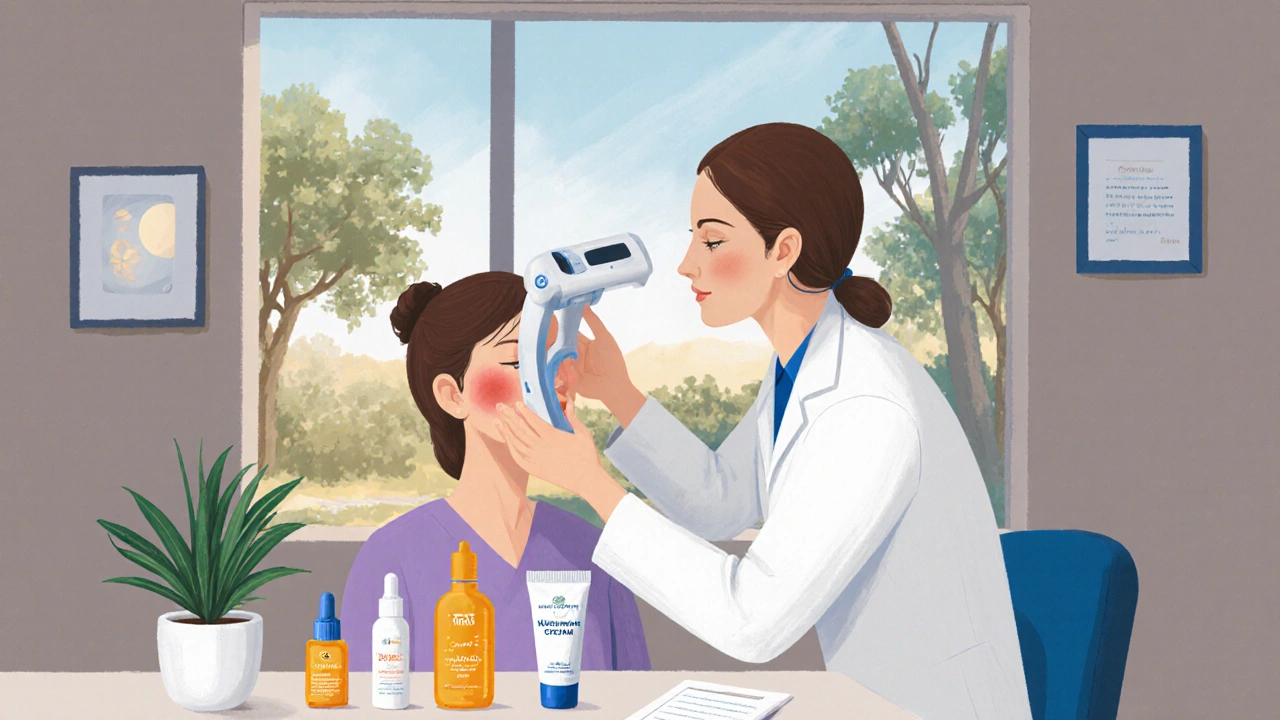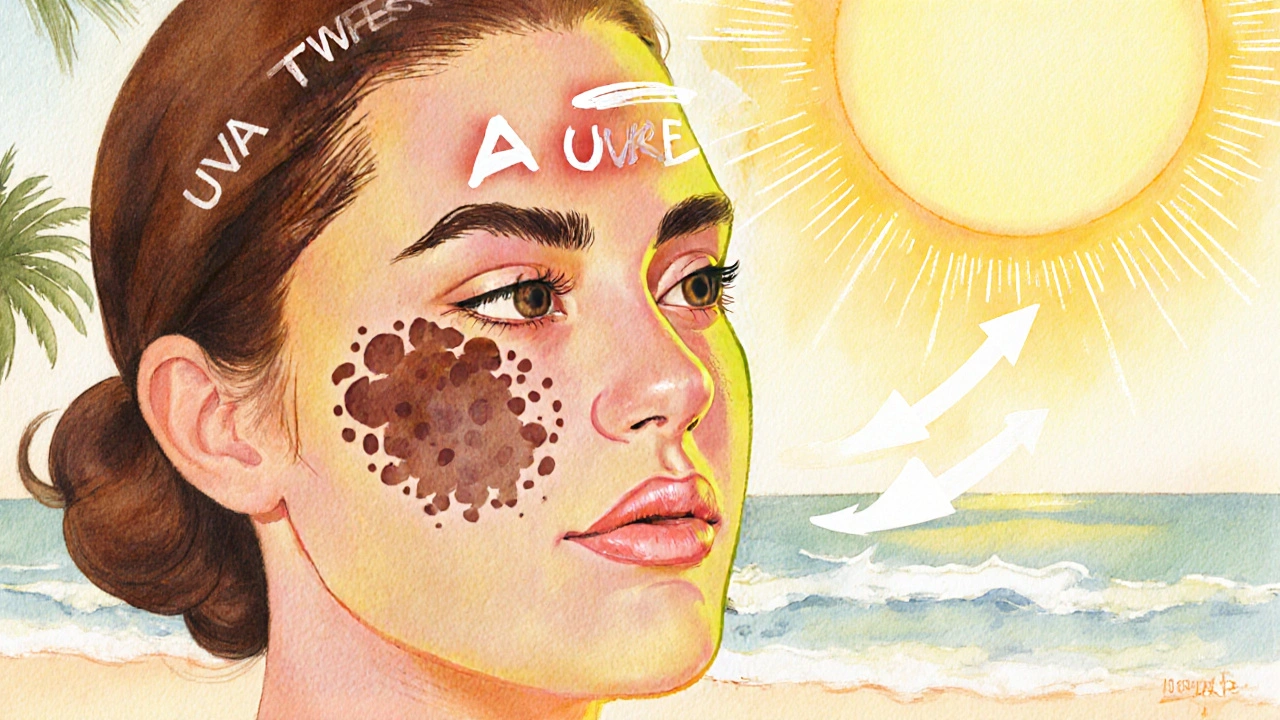Sunscreen Amount Calculator
Calculate Your Daily Sunscreen Needs
Based on dermatologist recommendations for melasma management. Proper application is critical for preventing dark spots.
Your Sunscreen Recommendation
Total Area: 0 cm²
Required Amount: 0 grams
Reapplication: Every 2 hours
Important: Dermatologists recommend 2mg/cm² for full protection. This calculation assumes proper application.
When the sun turns up the heat, people with Melasma is a chronic skin condition that causes dark, irregular patches, especially on the face. The extra UV exposure in summer can deepen those spots, making them harder to treat. This guide walks you through practical steps to keep your skin calm, protect it from the sun, and prevent melasma from getting worse during the hottest months.
Key Takeaways
- Broad‑spectrum sunscreen with SPF30+ is non‑negotiable.
- Mineral filters like zinc oxide are gentler for melasma‑prone skin.
- Daily antioxidants (vitaminC, niacinamide) help fade existing spots.
- Protective clothing and shade reduce UV load dramatically.
- Regular check‑ins with a dermatologist keep treatment on track.
Why Summer Makes Melasma Worse
Sunlight contains two harmful rays: UVA, which penetrates deep and triggers pigment production, and UVB, which burns the surface and also stimulates melanin. In people with melasma, the melanocytes are already over‑active, so any increase in UV exposure causes them to dump more pigment into the skin. Hormonal fluctuations (often from birth control pills or pregnancy) compound the issue, making the summer months a perfect storm for darker patches.
Sun Protection Foundations
The first line of defense is a reliable sunscreen. Look for a product labeled broad‑spectrum and with an SPF of at least 30. Broad‑spectrum means it blocks both UVA and UVB rays.
Two main families of sunscreen filters exist:
- Zinc Oxide is a mineral filter that sits on top of the skin, reflecting UV radiation. It’s photostable and less likely to irritate sensitive skin.
- Titanium Dioxide works similarly but offers slightly less UVA coverage. It’s often combined with zinc oxide for balanced protection.
Chemical filters (like avobenzone or octocrylene) absorb UV light and convert it to heat. They’re cosmetically elegant but can sometimes cause irritation on melasma‑affected skin.

Choosing the Right Sunscreen: Mineral vs. Chemical
| Attribute | Mineral (Zinc Oxide/Titanium Dioxide) | Chemical (Avobenzone, Octocrylene, etc.) |
|---|---|---|
| UV Coverage | Broad‑spectrum, excellent UVA/UVB | Broad‑spectrum, depends on blend |
| Skin Sensitivity | Low irritation risk | Higher irritation potential |
| Cosmetic Finish | Can leave a slight white cast | Generally invisible |
| Stability | Photostable | May degrade; requires stabilizers |
For melasma, many dermatologists recommend mineral sunscreens because they sit on the skin’s surface without triggering inflammation.
Daily Skincare Routine Adjustments
Beyond sunscreen, a targeted routine helps lighten existing patches and prevent new ones.
- Hydroquinone remains the gold‑standard depigmenting agent. Use a 2‑4% prescription cream nightly, but avoid sun exposure while it’s active.
- Azelaic Acid offers a gentler alternative, reducing pigment and inflammation at 15‑20% concentrations.
- Niacinamide (vitaminB3) improves barrier function and inhibits melanosome transfer, making it a daily hero.
- Vitamin C (10‑20% L‑ascorbic acid) works as an antioxidant, brightening spots and protecting against UV‑induced free radicals.
- Gentle, pH‑balanced cleansers remove excess oil without stripping the skin, preserving the barrier that keeps irritants out.
Apply these actives after cleansing and before sunscreen. Allow each layer to absorb for a minute to avoid dilution.
Protective Clothing & Accessories
Even the best sunscreen can miss spots on the nose, ears, or hairline. Physical barriers cut UV exposure dramatically.
- Wide‑brimmed hats (at least 3inches around) shade the face, neck, and ears.
- UV‑protective sunglasses block up to 99% of UVA/UVB and prevent pigment changes around the eyes.
- UPF Clothing is fabric rated for Ultraviolet Protection Factor; a UPF50 shirt blocks 98% of UV rays.
- Seek shade between 10am and 4pm when the sun is strongest.

When to See a Dermatologist
If you notice rapid darkening, itching, or new patches despite diligent sun protection, schedule a visit. A dermatologist can:
- Prescribe higher‑strength hydroquinone or combination therapies (retinoids + steroid + hydroquinone). \n
- Offer in‑office procedures like chemical peels, laser therapy, or microneedling, which can accelerate fading when used correctly.
- Tailor a skin‑type‑specific sunscreen regimen to avoid allergic reactions.
Early professional guidance prevents the condition from becoming entrenched.
Common Pitfalls & Quick Fixes
- Skipping sunscreen on cloudy days - UV rays penetrate clouds; always apply.
- Re‑applying only once - Re‑apply every two hours, especially after swimming or sweating.
- Using expired sunscreen - Potency drops after the expiration date; replace yearly.
- Choosing a “tanning” lotion - These often contain UVA‑only filters and can worsen melasma.
- Over‑exfoliating - Harsh scrubs damage the barrier, leading to more pigment production.
Fix these habits and you’ll notice a steadier improvement over the summer.
Frequently Asked Questions
Can I use a regular SPF 30 sunscreen for melasma?
A regular SPF 30 that’s labeled broad‑spectrum can work, but mineral formulas with zinc oxide or titanium dioxide are preferred because they’re less likely to irritate pigmented skin.
How often should I re‑apply sunscreen during a beach day?
Re‑apply every two hours, and immediately after swimming, toweling off, or heavy sweating.
Is hydroquinone safe for long‑term use?
Short‑term (up to 4months) use is considered safe under dermatologist supervision. For longer periods, alternating with azelaic acid or a combination cream reduces the risk of ochronosis.
Do antioxidants help fade melasma?
Yes. VitaminC and niacinamide neutralize free radicals caused by UV exposure and can gradually lighten existing spots when used consistently.
What’s the difference between UPF clothing and SPF sunscreen?
UPF rates the fabric’s ability to block UV radiation before it reaches the skin, while SPF measures how much longer skin can stay in the sun without burning. Both work together for optimal protection.
By layering smart sunscreen, supportive actives, and physical barriers, you can keep melasma from darkening under the summer sun and even start fading those stubborn patches. Stay consistent, protect early, and let a dermatologist guide any deeper interventions.


Rex Wang
October 14, 2025 AT 19:27Sunscreen is non‑negotiable!!
christian quituisaca
October 20, 2025 AT 20:47Absolutely, the sun’s UV barrage isn’t something you can outwit with a dab of SPF alone!! The mineral filters, especially zinc oxide, act like a tiny reflective shield that sits politely on your skin’s surface, keeping those rogue melanocytes at bay!! While chemical filters can be cosmetically sleek, they sometimes flirt with irritation, which is a nightmare for melasma‑prone folks!! Think of sunscreen as the foundation of a summer‑proof skincare routine, not an after‑thought!! And remember, re‑apply like clockwork, or you’ll be giving your melasma a free pass to darken.
Donnella Creppel
October 26, 2025 AT 22:07What if I told you that mineral sunscreens are over‑hyped and that a well‑formulated chemical filter can actually penetrate deeper and neutralize UV more effectively?? Many dermatologists push zinc oxide like it’s the holy grail, but those white casts are just a cosmetic inconvenience?? Plus, modern avobenzone‑based blends have stabilized for years, offering broad‑spectrum coverage without the gritty feel?? So, don’t dismiss chemicals outright; they’ve earned their place in the sunscreen pantheon.
Thomas Burke
November 1, 2025 AT 23:27That's a solid point, chemicals have come a long way, and some folks do tolerate them better than minerals.
Debbie Frapp
November 8, 2025 AT 00:47Indeed, newer photostable filters like bisoctrizole and bemotrizinol provide excellent UVA protection while maintaining a light texture. Pairing those with antioxidants such as vitamin C can further mitigate pigment‑stimulating pathways.
Michelle Abbott
November 14, 2025 AT 02:07Bottom line: SPF = cost, compliance = failure.
Alan Whittaker
November 20, 2025 AT 03:27Ever wonder why the big pharma pushes these “sunscreen” formulas? The narrative is engineered to keep us buying expensive creams while the hidden nanoparticles infiltrate our dermal layers, potentially disrupting melanin regulation. They’re not just UV blockers; they’re vectors for long‑term epigenetic changes, and the industry keeps quiet about it.
Michael Waddington
November 26, 2025 AT 04:47Mate, that's a stretch. The safety data on zinc and titanium is solid, and the nanoparticle concerns have been debunked in multiple peer‑reviewed studies. No conspiracy, just good science.
HAMZA JAAN
December 2, 2025 AT 06:07Oh, the tragedy! Imagine a world where everyone forgets to reapply and watches their melasma morph into a storm of darkness. It's like watching a painting fade under relentless glare-pure heartbreak!!
bob zika
December 8, 2025 AT 07:27It is imperative to emphasize that consistent application of broad‑spectrum sunscreen, coupled with adjunctive topical agents such as hydroquinone and niacinamide, constitutes a comprehensive strategy for melasma management during peak ultraviolet exposure periods.
Aditya Satria
December 14, 2025 AT 08:47Keep at it! Regular reapplication and a balanced routine with antioxidants can make a noticeable difference over weeks.